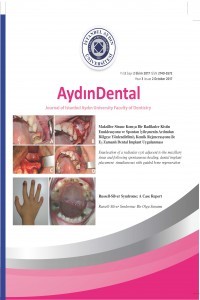Sahipli Köpeklerde Dens İnvajinatus Görülme Sıklığı: Bir Retrospektif Çalışma
Dens invaginatus, İntraoral Radiografi, Veteriner Dişhekimliği
A RETROSPECTIVE LOOK AT THE PREVALENCE OF DENS INVAGINATUS IN CLIENT-OWNED DOGS
Dens invaginatus, Intraoral Radiography, Veterinary Dentistry,
___
- 1. Kim C-G, Lee S-Y, Kim J-W, Park H-M. Assessment of dental abnormalities by full-mouth radiography in small breed dogs. Journal of the American Animal Hospital Association. 2013;49(1):23-30.
- 2. Colmery B, 3rd. The gold standard of veterinary oral health care. Vet Clin North Am Small Anim Pract. 2005;35(4):781-7, v.
- 3. Stein KE, Marretta SM, Eurell JAC. Dens invaginatus of the mandibular first molars in a dog. Journal of veterinary dentistry. 2005;22(1):21-5.
- 4. Coffman CR, Visser CJ, Visser L. Endodontic treatment of dens invaginatus in a dog. Journal of veterinary dentistry. 2009;26(4):220-5.
- 5. Duncan HL. Diagnostic Imaging in Veterinary Dental Practice. Journal of the American Veterinary Medical Association. 2010;237(11):1251-3.
- 6. Mulligan T AM, Williams CA. . Atlas of canine and feline dental radiography. (NJ) T, editor1998.
- 7. Woodward TM. Dental radiology. Topics in companion animal medicine. 2009;24(1):20-36.
- 8. Gorrel C. Radiographic evaluation. Vet Clin North Am Small Anim Pract. 1998;28(5):1089-110.
- 9. Verstraete FJ, Kass PH, Terpak CH. Diagnostic value of full-mouth radiography in dogs. Am J Vet Res. 1998;59(6):686-91.
- 10. Tsugawa AJ, Verstraete FJ. How to obtain and interpret periodontal radiographs in dogs. Clinical techniques in small animal practice. 2000;15(4):204-10.
- 11. Tsugawa AJ, Verstraete FJ, Kass PH, Görrel C. Diagnostic value of the use of lateral and occlusal radiographic views in comparison with periodontal probing for the assessment of periodontal attachment of the canine teeth in dogs. Am J Vet Res. 2003;64(3):255-61.
- 12. Harvey CE EP. Small animal dentistry. St. Louis (MO): Mosby; 1993.
- 13. Gallacher A, Ali R, Bhakta S. Dens invaginatus: diagnosis and management strategies. British Dental Journal. 2016;221(7):383-7.
- 14. Eden EK, Koca H, Sen BH. Dens invaginatus in a primary molar: report of case. ASDC J Dent Child. 2002;69(1):49-53, 12.
- 15. Gound TG. Dens invaginatus--a pathway to pulpal pathology: a literature review. Pract Periodontics Aesthet Dent. 1997;9(5):585-94; quiz 96.
- 16. Chen YH, Tseng CC, Harn WM. Dens invaginatus. Review of formation and morphology with 2 case reports. Oral Surg Oral Med Oral Pathol Oral Radiol Endod. 1998;86(3):347-52.
- 17. Kulild JC, Weller RN. Treatment considerations in dens invaginatus. J Endod. 1989;15(8):381-4.
- 18. Rotstein I, Stabholz A, Heling I, Friedman S. Clinical considerations in the treatment of dens invaginatus. Endod Dent Traumatol. 1987;3(5):249-54.
- 19. Oehlers F. Dens invaginatus (dilated composite odontome): I. Variations of the invagination process and associated anterior crown forms. Oral Surgery, Oral Medicine, Oral Pathology. 1957;10(11):1204-18.
- 20. Wells DW, Meyer RD. Vital root canal treatment of a dens in dente. J Endod. 1993;19(12):616-7.
- 21. Ruprecht A, Sastry KA, Batniji S, Lambourne A. The clinical significance of dental invagination. J Pedod. 1987;11(2):176-81.
- 22. Colby RA KD, Robinson HBG. . Color atlas of oral pathology. Philadelphia: JB Lippincott; 1961.
- 23. Hunter HA. Dilated composite odontome; reports of two cases, one bilateral and one radicular. Oral Surg Oral Med Oral Pathol. 1951;4(5):668-73.
- 24. Peyneau PD, da Costa ED, Verner FS, de Freitas DQ, Almeida SM, Ambrosano GMB. Cone beam computed tomography in the diagnosis of dens invaginatus: Case report. International journal of odontostomatology. 2017;11(1):89-94.
- 25. Thakur S, Thakur NS, Bramta M, Gupta M. Dens invagination: A review of literature and report of two cases. Journal of natural science, biology, and medicine. 2014;5(1):218.
- 26. Coraini C, Mascarello T, de Palma CM, Gobbato EA, Costa R, de Micheli L, et al. Endodontic and periodontal treatment of dens invaginatus: report of 2 clinical cases. Giornale Italiano di Endodonzia. 2013;27(2):86-94.
- 27. Alani A, Bishop K. Dens invaginatus. Part 1: classification, prevalence and aetiology. International endodontic journal. 2008;41(12):1123-36.
- 28. Hamasha AA, Alomari QD. Prevalence of dens invaginatus in Jordanian adults. International endodontic journal. 2004;37(5):307-10.
- 29. Kirzioglu Z, Ceyhan D. The prevalence of anterior teeth with dens invaginatus in the western Mediterranean region of Turkey. International endodontic journal. 2009;42(8):727-34.
- ISSN: 2149-5572
- Yayın Aralığı: Yılda 3 Sayı
- Başlangıç: 2015
- Yayıncı: İstanbul Aydın Üniversitesi
COVİD19 POZİTİF BİREYLERDE OLASI ORAL SEMPTOMLAR
Baş Boyun Kanserlerinde İmplant Tedavisi
Özge TURAN, Elçin TEKİN BULUT, Evcim ÇEKER
Geriatrik Hastalarda Endodontik Tedavi Zorlukları
Sahipli Köpeklerde Dens İnvajinatus Görülme Sıklığı: Bir Retrospektif Çalışma
Antitrombotik İlaçların Kullanımında İmplant Tedavileri
Polivinil Siloksan Ölçü Materyalleri
Melis Nişanuhi PALANCIOĞLU, Deniz SEN
PEDİATRİK VON WILLEBRAND OLGULARINDA ANESTEZİK YAKLAŞIM: OLGU SUNUMU
Oklüzo-Gingival Boyu Yetersiz Dişlere Yapılan Sabit Protezlerde Tutuculuğu Etkileyen Faktörler
